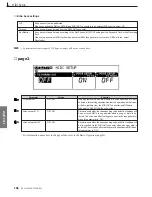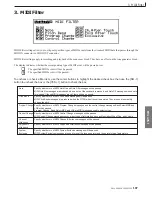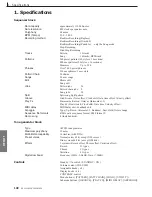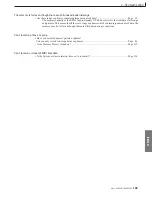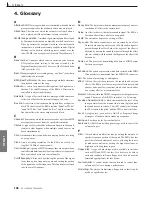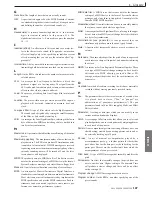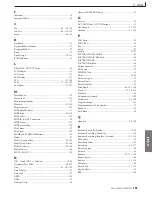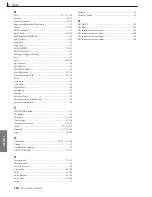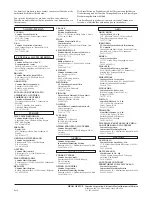
RM1x SEQUENCE REMIXER
147
APPENDIX
G
Gate time:
The length of time that a note actually sounds.
GM:
A specification approved by the MIDI Standards Commit-
tee, standardizing the basic functionality of a tone generator,
and defining the number of voices and sounds, etc.
H
Hexadecimal:
A system of numbering based on 16, in which the
digits increment in units of n-th powers of 16. The
alphabetical characters A – F are used to express the numbers
10 – 15.
I
Insertion (effect):
An effect used in Voice submode as a major fac-
tor in the character of a sound. In Song mode, an insertion
effect will apply only to the specified part (unlike a system
effect), meaning that you can use the insertion effect “ag-
gressively.”
Interval time:
A delay time that is inserted at regular intervals when
transmitting bulk data that was recorded in a sequence track.
L
Length:
On the RM1x this indicates the number of measures in the
selected phrase.
LFO:
An acronym for Low Frequency Oscillator, a block that
produces a signal at a low frequency. The signal from the
LFO can be used to modulate pitch, volume or tone to produce
effects such as vibrato, tremolo and wah.
Load:
The process of reading data from floppy disk into internal
memory.
Location:
The place within a song at which notes will be input or
playback will be started, indicated as measure, beat, and
clock.
Low pass filter:
A type of filter which cuts the high frequencies.
The sound can be brightened by raising the cutoff frequency
of the filter, or darkened by lowering it.
LSB:
An acronym for Least Significant Byte, referring to the lower
byte of data when MIDI control change data is divided into
two bytes for transmission.
M
Master tune:
A parameter that adjust the overall tuning of the entire
device.
Maximum polyphony:
The maximum number of notes that can be
played at once. The RM1x can produce 32 simultaneous notes
(counted in 1-element units). If MIDI messages are received
requesting more notes than the maximum polyphony allows,
currently sounding notes will be turned off, and the later-
received notes will be played.
MDF3:
The product name of a MIDI data filer. This device receives
data for the internal settings of a MIDI device in the form of
System Exclusive messages, and stores them to floppy disk.
Measure:
A unit of musical duration consisting of several beats.
MIDI:
An acronym for Musical Instruments Digital Interface, a
standard for transferring data between musical instruments.
Most electronic musical instruments today implement the
MIDI specification and provide MIDI connectors. Such in-
struments can be connected together to create remote per-
formance or automatic performance systems.
MIDI data filer:
A MIDI device that receives data for the internal
settings of a MIDI device in the form of System Exclusive
messages, and stores them to floppy disk. An example is the
Yamaha MDF3 MIDI data filer.
Modulation wheel:
A controller that can be used to smoothly modify
the volume, tone or pitch while you perform.
MSB:
An acronym for Most Significant Byte, referring to the upper
byte of data when MIDI control change data is divided into
two bytes for transmission.
Multi-timbral tone generator:
A tone generator that can
simultaneously produce more than one type of sound.
Mute:
A function that temporarily silences a track or reduces its
volume.
N
Note name:
The name which specifies the pitch of a note, expressed
as a character, a sharp or flat symbol, and a number indicating
the octave.
NRPN:
An acronym for Non Registered Parameter Number. These
are a type of MIDI control change message, and are used to
edit sounds via MIDI, allowing you to edit filter or EG
settings, or adjust the pitch or level for each instrument of a
drum voice.
O
Overdub:
A method of realtime recording in which new material is
recorded without erasing previously recorded tracks.
P
Pan:
The parameter that sets the stereo location of a sound when
it is played back in stereo. (“Pan” or “panpot” are
abbreviations of “panoramic potentiometer.”) The pan
parameters found in Voice Edit, song play Multi, and Effect
Edit are linked.
Parameter:
A setting or data item which you can modify in the
various mode and submode displays.
Patch:
A screen page in Pattern mode that allows you to select and
playback patterns, and to create patterns by assigning phrases
to each track of the pattern.
Pattern:
An accompaniment pattern consisting of drums, bass and
chord backing, created by connecting phrases end-to-end or
by vertically stacking up to16 parts.
Phrase:
A unit of musical accompaniment played by a
accompaniment part; e.g., a rhythm pattern for the rhythm
part, a bass line for the bass part, or chord backing for the
guitar part. Phrases are the smallest unit from which the
accompaniment of a song is created.
Pitch bend:
A type of MIDI message that smoothly modifies the
pitch.
Portamento:
An effect that smoothly changes the pitch from one
note to another note. Higher settings of Portamento Time
will produce a slower change, and there will be no effect
with a setting of 0.
Program change:
A MIDI message that selects a voice.
Program number:
On the RM1x, a number specifying one of the
preset sounds.
4. Glossary
Содержание RM1x
Страница 1: ......
Страница 44: ...44 RM1x SEQUENCE REMIXER BASIC CONCEPT MEMO ...
Страница 130: ...SONG MODE 130 RM1x SEQUENCE REMIXER MEMO ...
Страница 138: ...138 RM1x SEQUENCE REMIXER UTILITY MODE MEMO ...
Страница 154: ...M D G EMI Division Yamaha Corporation 1998 V343990 810CMIT18 2 02B0 Printed in Japan ...




